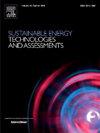Advancement in power-to-methanol integration with steel industry waste gas utilization through solid oxide electrolyzer cells: Surrogate model-based approach for optimization
IF 7.1
2区 工程技术
Q1 ENERGY & FUELS
Sustainable Energy Technologies and Assessments
Pub Date : 2025-01-01
DOI:10.1016/j.seta.2024.104160
引用次数: 0
Abstract
This study introduces an innovative approach using solid oxide electrolysis cells (SOEC) to co-electrolyze CO2 and H2O from steel industry emissions, converting them into syngas for methanol synthesis. To optimize this process, a surrogate model-based deep neural network (DNN) is employed. The process simulation result shows strong agreement between the model and experimental data, validated by polarization curves and product comparisons, with low RMSE values indicating its validity for generating data in subsequent processes. The DNN surrogate model accurately predicted key performance metrics, with high R2 values for methanol production and power consumption, demonstrating its capability as a surrogate model for process simulation and use for further optimization. Optimization revealed that the ideal conditions for methanol synthesis occur at high temperatures, with low current density and steam flow. Additionally, the surrogate-based optimization method reduced computational time by a factor of 20. The use of SOEC dramatically enhanced methanol production, achieving nearly 10 times the productivity of systems without SOEC integration. This improvement also led to a substantial reduction in CO2 emissions intensity, with the plant predicted to produce near-zero carbon emissions due to increased production efficiency and CO2 utilization.

求助全文
约1分钟内获得全文
求助全文
来源期刊

Sustainable Energy Technologies and Assessments
Energy-Renewable Energy, Sustainability and the Environment
CiteScore
12.70
自引率
12.50%
发文量
1091
期刊介绍:
Encouraging a transition to a sustainable energy future is imperative for our world. Technologies that enable this shift in various sectors like transportation, heating, and power systems are of utmost importance. Sustainable Energy Technologies and Assessments welcomes papers focusing on a range of aspects and levels of technological advancements in energy generation and utilization. The aim is to reduce the negative environmental impact associated with energy production and consumption, spanning from laboratory experiments to real-world applications in the commercial sector.
 求助内容:
求助内容: 应助结果提醒方式:
应助结果提醒方式:


